南京明孝陵导游词英文
新明孝陵导游词
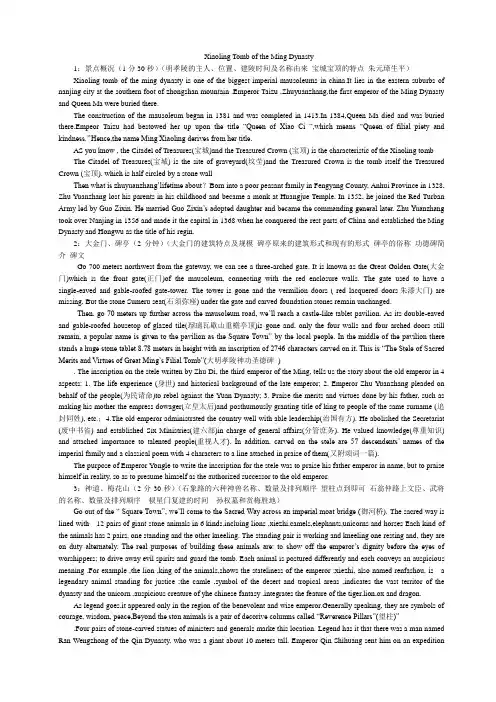
Xiaoling Tomb of the Ming Dynasty1:景点概况(1分30秒)(明孝陵的主人、位置、建陵时间及名称由来宝城宝顶的特点朱元璋生平)Xiaoling tomb of the ming dynasty is one of the biggest imperial mausoleums in china.It lies in the eastern suburbs of nanjing city at the southern foot of zhongshan mountain .Emperor Taizu ,Zhuyuanzhang,the first emperor of the Ming Dynasty and Queen Ma were buried there.The construction of the mausoleum began in 1381 and was completed in 1413.In 1384,Queen Ma died and was buried there.Empeor Taizu had bestowed her up upon the title “Queen of Xiao Ci “,which means “Queen of filial piety and kindness.’’Hence,the name Ming Xiaoling derives from her title.AS you know , the Citadel of Treasures(宝城)and the Treasured Crown (宝顶) is the characteristic of the Xiaoling tomb The Citadel of Treasures(宝城) is the site of graveyard(坟茔)and the Treasured Crown is the tomb itself the Treasured Crown (宝顶), which is half circled by a stone wallThen what is zhuyuanzhang’lifetime about?Born into a poor peasant family in Fengyang County, Anhui Province in 1328, Zhu Y uanzhang lost his parents in his childhood and became a monk at Huangjue Temple. In 1352, he joined the Red Turban Army led by Guo Zixin. He married Guo Zixin’s adopted daughter and became the commanding general later. Zhu Y uanzhang took over Nanjing in 1356 and made it the capital in 1368 when he conquered the rest parts of China and established the Ming Dynasty and Hongwu as the title of his regin.2:大金门、碑亭(2分钟)(大金门的建筑特点及规模碑亭原来的建筑形式和现有的形式碑亭的俗称功德碑简介碑文Go 700 meters northwest from the gateway, we can see a three-arched gate. It is known as the Great Golden Gate(大金门)which is the front gate(正门)of the mausoleum, connecting with the red enclosure walls. The gate used to have a single-eaved and gable-roofed gate-tower. The tower is gone and the vermilion doors ( red lacquered doors朱漆大门) are missing. But the stone Sumeru seat(石须弥座) under the gate and carved foundation stones remain unchanged.Then, go 70 meters up further across the mausoleum road, we’ll reach a castle-like tablet pavilion. As its double-eaved and gable-roofed housetop of glazed tile(瑠璃瓦歇山重檐亭顶)is gone and, only the four walls and four arched doors still remain, a popular name is given to the pavilion as the Square Town” by the local people. In the middle of the pavilion t here stands a huge stone tablet 8.78 meters in height with an inscription of 2746 characters carved on it. This is “The Stele of S acred Merits and Virtues of Great Ming’s Filial Tomb”(大明孝陵神功圣德碑). The inscription on the stele written by Zhu Di, the third emperor of the Ming, tells us the story about the old emperor in 4 aspects: 1. The life experience (身世) and historical background of the late emperor; 2. Emperor Zhu Y uanzhang pleaded on behalf of the people(为民请命)to rebel against the Yuan Dynasty; 3. Praise the merits and virtues done by his father, such as making his mother the empress dowager(立皇太后)and posthumously granting title of king to people of the same surname (追封同姓), etc.;4.The old emperor administrated the country well with able leadership(治国有方). He abolished the Secretariat (废中书省) and established Six Ministries(建六部)in charge of general affairs(分管庶务). He valued knowledge(尊重知识) and attached importance to talented people(重视人才). In addition, carved on the stele are 57 descendents’ names of the imperial family and a classical poem with 4 characters to a line attached in praise of them(又附颂词一篇).The purpose of Emperor Yongle to write the inscription for the stele was to praise his father emperor in name, but to praise himself in reality, so as to presume himself as the authorized successor to the old emperor.3:神道、梅花山(2分30秒)(石象路的六种神兽名称、数量及排列顺序望柱点到即可石翁仲路上文臣、武将的名称、数量及排列顺序棂星门复建的时间孙权墓和赏梅胜地)Go out of the “ Square Town”, we’ll come to the Sacred Way across an imperial moat bridge (御河桥). The sacred way is lined with 12 pairs of giant stone animals in 6 kinds.incluing lions ,xiezhi,camels,elephants,unicorns and horses Each kind of the animals has 2 pairs, one standing and the other kneeling. The standing pair is working and kneeling one resting and, they are on duty alternately. The real purposes of building these animals are: to show off the emperor’s dignity before the eyes of worshippers; to drive away evil spirits and guard the tomb. Each animal is postured differently and each conveys an auspicious meaning .For example ,the lion ,king of the animals,shows the stateliness of the emperor ;xiezhi, also named renfashou, is a legendary animal standing for justice ;the camle ,symbol of the desert and tropical areas ,indicates the vast territor of the dynasty and the unicorn ,auspicious creature of yhe chinese fantasy ,integrates the feature of the tiger,lion,ox and dragon.As legend goes,it appeared only in the region of the benevolent and wise emperor.Generally speaking, they are symbols of courage, wisdom, peace,Beyond the ston animals is a pair of decorive columns called “Reverence Pillars”(望柱)”.Four pairs of stone-carved statues of ministers and generals marke this location. Legend has it that there was a man named Ran Wengzhong of the Qin Dynasty, who was a giant about 10 meters tall. Emperor Qin Shihuang sent him on an expeditionagainst Xiongnu, an ancient nationality in north China. After he died, a bronze statue was cast for him in Xianyang Palace. Since the time all the bronze statues and stone statues put before a tomb have been called Weng Zhong. At the end of the sacred avenue, there used to be a gate named Lingxing Gate with three arches. and it was rebuilted in 2007 January 30 ..From here the Sacred Way turns into a north-south direction and becomes known as Wengzhong Road nd circles a small hill planted with thousands of plum trees. It is the Plum Hill, which is the tomb of Sun Quan, the king of the Eastern Wu kingdom. It is said that some royal ministers of the Ming suggested moving the tomb aw ay when the emperor’s mausoleum was under construction. But the emperor did not agree and praised Sun Quan to be a good fellow and let him stay to be the concierge of his tomb. The plum hill is now a wonderful site for local people to admire plum blossom in spring when the trees are blooming.4:金水桥、陵门、碑殿(2分30秒)(过金水桥点到即可陵门建筑特点“特别告示”碑及六国文字碑殿内五块石碑的名称及内容)Passing jinshui Bridge , we’ll come to the Tomb Gate(陵门). The arch gate has 5 doorways, with yellow glazed tiles, red walls and doors. But this gate was rebuilt in 1999. The lintel of the gate is engraved with three Chinese characters meaning “Xiaoling Tomb of the Ming Dynasty or The Ming’s Filial Tomb”. The name “Xiaoling” was given by the emperor himself, but the word “Ming” was added to later in the Qing times.At the foot of the gate,there is a “special notice “stone tablet carved in six languages(Japanese,German,ltalian,English,Frenchand Russian),notifying visitors of the importance of the mausoleum.Inside the gate is the Imperial Tablet Hall.There are five tablets displayed in it .In the middle tablet ,it is carved on four chinese characters”Zhi Long Tang Song “,meaning the state of Ming taizu even better than emperor Taizong of the Tang Dynasty and Emperor Taizu of the Song Dynasty ,two successful emperors in the chinese history written by Kangxi during his third inspection tour to southern China .Cao Yin ,grandfather of Cao xueqin a,grate writer inscribed it on the tablet .Besides the middle big tablet ,there are also two tablets inscribed with a poem composed by the emperor. Qian Long. At each back of the two steles there are two sleeping tomb stones carved with the titles wrritened by Vicery of laingjiang in Qing dynasty .5:享殿遗址(1分30秒)(享殿过去和现在的用途原来的规模及现在可见的景观)Go out of the pavilion, we’ll come t o the site of xiang hall. The original hall was very large in a width of 9 rooms(九开间). It was used to enshrine Emperor Zhu Yuanzhang and his empress.while now it is a pace to vist and a shop dealing in souvenis.Figures og Emperor taizu and Queen Ma are hanging inside on the wall.The hall was destroyed yet its 56 stone column bases are still there. There are also three stone-carved patterns laid between the two-way parallel flights of stairs outside the hall ,depicting various scenes like “the two dragons playing with a pearl,””the blazing sun over the country “and “a heavenly steed soaring across the skies.” On both sides of the Filial Hall there used to have a number of side halls for enshrining imperial concubines buried with the dead emperor(陪葬妃子). The present Filial Hall with only three rooms is much smaller than the original. It was rebuilt and twicely restored for the tomb guards during the Tongzhi reign of the Qing Dynasty. But now it only has some portraits of the emperor and the crown prince(太子) done by later generations hanging on the walls.6方城,明楼,宝城、宝顶(2分钟)(方城明楼的布局建筑特色宝城、宝顶的规模、形状和建造特点)Then through the Inner Red Gate,you will come to the Fang Cheng .The base of Fang Cheng has an arched passageway in the middle. Along the 54 steps, you will see t he south wall of the tomb carved with seven Chinese characters meaing “this hill is the tomb of Emperor Taizu of Ming “,which was written in the early time of Republic of Chian.Here,it is divided into two paths,one is leading up to Ming Tower.Ming Tower faces south with three arched entrances facing east ,west ,and north respective.The roof of ming tower has collapsed over the years,but the walls remians.In 2009,the government rebuilt the roof in order to keep it better. The other path leads to Baocheng ,which refers to the wall around the tomb.The top of the mausoleum is situated at Dulongfu of Wanzhu Peak at the southern foot of Zhongshan Mountain .Baoding is covered by a large circled earthen mound ,325-400meters in diameter.The tomb of Emperor Taizu and Queen Ma is just beneath.Xiaoling tomb of the Ming Dynasty is renowed for its unique design,its eminent status,its amazing beauty and its magnificent scale.It is the milestone in the historical development of Chinese mausoleums.As an extension of the “imp erial tombs of the Ming and Qing dynasties”,it is listed by UNESCO as a world cultural heritage site.。
南京明孝陵英语作文
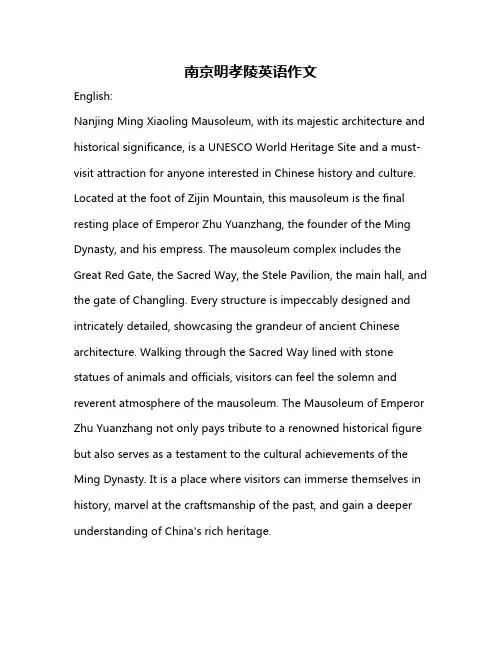
南京明孝陵英语作文English:Nanjing Ming Xiaoling Mausoleum, with its majestic architecture and historical significance, is a UNESCO World Heritage Site and a must-visit attraction for anyone interested in Chinese history and culture. Located at the foot of Zijin Mountain, this mausoleum is the final resting place of Emperor Zhu Yuanzhang, the founder of the Ming Dynasty, and his empress. The mausoleum complex includes the Great Red Gate, the Sacred Way, the Stele Pavilion, the main hall, and the gate of Changling. Every structure is impeccably designed and intricately detailed, showcasing the grandeur of ancient Chinese architecture. Walking through the Sacred Way lined with stone statues of animals and officials, visitors can feel the solemn and reverent atmosphere of the mausoleum. The Mausoleum of Emperor Zhu Yuanzhang not only pays tribute to a renowned historical figure but also serves as a testament to the cultural achievements of the Ming Dynasty. It is a place where visitors can immerse themselves in history, marvel at the craftsmanship of the past, and gain a deeper understanding of China's rich heritage.中文翻译:南京明孝陵,以其雄伟的建筑和历史意义,是一处联合国教科文组织世界遗产,也是任何对中国历史和文化感兴趣的人必去的景点。
南京明孝陵英语作文
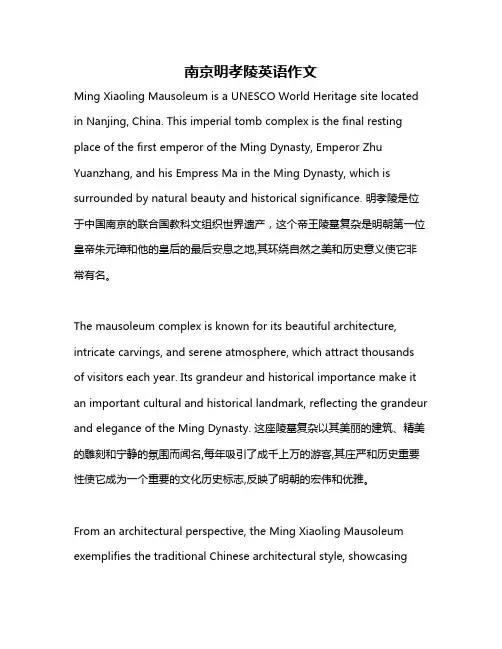
南京明孝陵英语作文Ming Xiaoling Mausoleum is a UNESCO World Heritage site located in Nanjing, China. This imperial tomb complex is the final resting place of the first emperor of the Ming Dynasty, Emperor Zhu Yuanzhang, and his Empress Ma in the Ming Dynasty, which is surrounded by natural beauty and historical significance. 明孝陵是位于中国南京的联合国教科文组织世界遗产,这个帝王陵墓复杂是明朝第一位皇帝朱元璋和他的皇后的最后安息之地,其环绕自然之美和历史意义使它非常有名。
The mausoleum complex is known for its beautiful architecture, intricate carvings, and serene atmosphere, which attract thousands of visitors each year. Its grandeur and historical importance make it an important cultural and historical landmark, reflecting the grandeur and elegance of the Ming Dynasty. 这座陵墓复杂以其美丽的建筑、精美的雕刻和宁静的氛围而闻名,每年吸引了成千上万的游客,其庄严和历史重要性使它成为一个重要的文化历史标志,反映了明朝的宏伟和优雅。
From an architectural perspective, the Ming Xiaoling Mausoleum exemplifies the traditional Chinese architectural style, showcasingintricate and magnificent structures such as the Sacred Way, the Elephant Road, and the main tomb structure. These architectural marvels not only reflect the artistic achievements of the time but also serve as a testament to the grandeur and power of the Ming Dynasty. 从建筑的角度看,明孝陵展示了传统的中国建筑风格,包括神道、大象路和主墓建筑等复杂而宏伟的建筑结构,这些建筑奇迹不仅反映了当时的艺术成就,而且也见证了明朝的宏伟和力量。
南京明孝陵英语作文
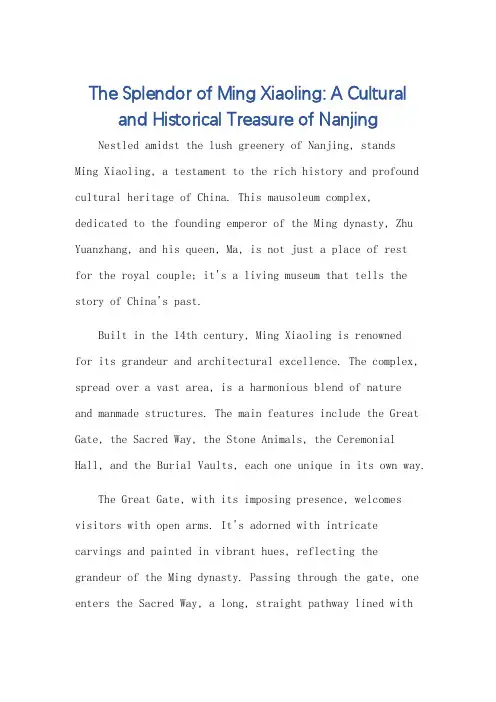
The Splendor of Ming Xiaoling: A Cultural and Historical Treasure of NanjingNestled amidst the lush greenery of Nanjing, standsMing Xiaoling, a testament to the rich history and profound cultural heritage of China. This mausoleum complex, dedicated to the founding emperor of the Ming dynasty, Zhu Yuanzhang, and his queen, Ma, is not just a place of restfor the royal couple; it's a living museum that tells the story of China's past.Built in the 14th century, Ming Xiaoling is renownedfor its grandeur and architectural excellence. The complex, spread over a vast area, is a harmonious blend of natureand manmade structures. The main features include the Great Gate, the Sacred Way, the Stone Animals, the Ceremonial Hall, and the Burial Vaults, each one unique in its own way. The Great Gate, with its imposing presence, welcomes visitors with open arms. It's adorned with intricate carvings and painted in vibrant hues, reflecting the grandeur of the Ming dynasty. Passing through the gate, one enters the Sacred Way, a long, straight pathway lined withstone animals, each symbolizing a different aspect of royal power and dignity.The Ceremonial Hall, located at the heart of the complex, is a magnificent structure that once hosted royal ceremonies and rites. Its interior is adorned withbeautiful murals and carvings, depicting scenes from Chinese mythology and history.But the real highlight of Ming Xiaoling is the Burial Vaults, where the remains of Zhu Yuanzhang and his queen rest. These vaults, carved out of solid rock, are a testament to the advanced engineering skills of the Ming dynasty. They are adorned with intricate carvings and paintings, telling the story of the emperor's life and reign.But Ming Xiaoling is not just about architecture and history; it's also about the beauty of nature. Surrounded by lush green hills and serene lakes, the complex offers a peaceful and serene atmosphere that is truly refreshing. Visitors can take a leisurely walk through the gardens, admire the scenic views, and relish the tranquility that this place offers.Ming Xiaoling is not just a place to visit; it's an experience. It offers a window into the rich history and profound culture of China, allowing visitors to connect with their past and appreciate the legacy of their ancestors. Whether you're an architecture enthusiast, a history buff, or just looking for a peaceful getaway, Ming Xiaoling is sure to leave a lasting impression.**南京明孝陵:文化与历史的瑰宝**南京,这座历史悠久的城市,孕育着无数文化和历史的瑰宝。
南京明孝陵英文导游词
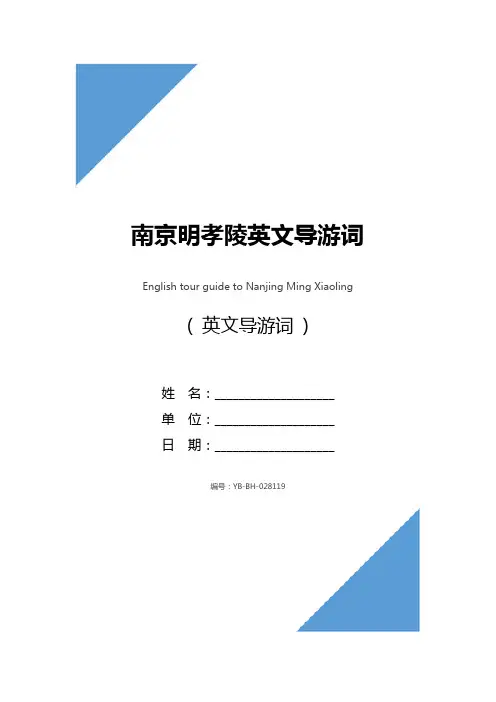
( 英文导游词)姓名:____________________单位:____________________日期:____________________编号:YB-BH-028119南京明孝陵英文导游词English tour guide to Nanjing Ming Xiaoling南京明孝陵英文导游词南京明孝陵导游词英文Ming Xiaoling Mausoleum is the first emperor of the Ming Dynasty and the queen Zhu Yuanjin Ma burial tomb, which is located in the southern foot of the purple mountain long Fu play in Mount Everest, Nanjing is the largest and one of the best preserved imperial tombs.So far more than 600 years of history.The emperors in ancient China chose the site of the mausoleum very carefully, and paid special attention to choosing the land of "Ji Di", that is, the place of geomantic omen.Every time I go out the site, in addition to sending one or two court officials, but also absorb the knowledge of geography, will see the alchemist in Feng shui.After selecting the mausoleum, the emperor had to examine the scene himself and was satisfied with it and was finally finalized.Soon after Zhu Yuanzhang ascended the throne, he was concerned about the "paradise" after his death, and began to plan the construction of the mausoleum.It is said that he has called Liu Bowen, Xu Da, Tang He, and other ministers todiscuss site selection.Five people agreed to write their respective best burial sites on paper and then open them at the same time.The results are written, Great minds think alike., Dulong Fu Mount Everest ".So the site of the tomb of Zhu Yuanjin was thus fixed.Dulong Fu is a hill located beneath the Zijin Mountain peak, 150 meters high, about 400 meters in diameter, is like a huge natural grave.Chinese feudal emperor often put themselves as sons of the heaven, to build the tomb in Dulong Fu, is in line with the requirements of the feudal superstition.Ming Xiaoling Mausoleum Yu Wu nine years (1376) began to build, build competent mausoleum engineering enterprises is "Dudu Fu Li xin.At that time, a large number of migrant workers were employed, and dozens of temples were left behind by their predecessors.Since the Eastern Jin Dynasty and the Southern Dynasties, Buddhism has been widely spread in China. The emperor of Wu even regards Buddhism as a national religion, so the temples in Nanjing are numerous.In the Eastern Jin Dynasty, there were more than 300 Buddhist temples, nearly 500 in the Southern Dynasties, and 100 thousand monks.His poetry in the Tang Dynasty: "in the four hundred and eighty temple, how many loutai yanyu."It was the portrayal of the flourishing Buddhist temples in Nanjing.In addition to moving to the temple, even moved a lot of previous tombs.But when moving to the Three Kingdoms, the tomb of Sun Quan (now on Mount Mei Shan in Nanjing), Zhu Yuanjin said, "SunQuan is a true man, keeping him as a gatekeeper."."It was not removed.Hongwu fifteen years (1382), the first phase of the project completed, coincided with the empress Ma's death, Zhu Yuanjin held a grand funeral for her, and the coffin burial tomb, called her "Xiaoci Queen", which is also the name of the tomb.In 1383, the main project of the tomb built hall.In 1392, the crown prince ZhuBiao died and was buried in the tomb of the East, called dongling.Hongwu thirty-one years (1398) built "Ming Tomb magic holiness monument", the construction of the mausoleum engineering ended, the project took 23 years.Before the death of Zhu Yuanjin, had left a testament; "funeral to frugality, no Jin, change because of the tomb and the world, three subjects are released, as marriage."This is obviously Zhu Yuanzhang's trick of buying people's hearts.The whole Ming Xiaoling Mausoleum building, Xiaolingwei East, South to West Fang Weigang dismount, the walls of the city, north of Longgang only halfway up the mountain, a radius of more than 20 km, is a grand scale.In the long 23 years of construction, depletion of the flesh and blood of the people.At that time, there were ten thousand trees planted in the tomb area, thousands of deer kept and 5700 guards.Its wide range, large scale, before the Ming Dynasty is rare.But Zhu Yuanjin was buried, there are 40 concubines to bury, in which 2 people were buried in the tomb of the East and west sides, 38 people from the buried in the tomb.This China exposed the feudal ruling class was cruel, they notonly to enjoy the splendor rich, after death still "death", the burial, at the people life.南京明孝陵导游词英文Xiaoling Tomb of the Ming DynastyHello, everybody! Welcome to Xiaoling Tomb of the Ming Dynasty. It is the first world cultural heritage site in Nanjing.Xiaoling Tomb is situated at the southern foot of Zijin Mountain in the east part of Nanjing, Jiangsu Province. It is the burial place of Zhu Yuanzhang, the first emperor of the Ming Dynasty, and his wife empress Ma. As one of the largest imperial tombs existent in China, Xiaoling became a major historic and cultural site under state protection in 1961. On July 3, 20xx, together with the 13 Ming Tombs in Beijing, it was accepted into the World Heritage List as an associated site of “the imperial tombs of the Ming and Qing Dynasties”.Ming Dynasty was the penult feudal regime in China’s history. Its founder, Zhu Yuanzhang, was often referred to as a “beggar emperor”for his miserable childhood.Zhu was born into a poor peasant family in 1328 in Anhui Province neighboring Jiangsu. In 1344, a serious drought and plague swept the north of the Huaihe River. All his family members died in succession during the disaster. To support himself, he entered a monastery near his village to be a monk at the age of 17, but before long he was sent out tobeg alms for survival until 1348. At that time, peasant uprisings against the oppression of the Yuan Dynasty broke out in many places. One of the strongest forces was the Red Tie Army, so named because every soldier wore a red tie on the neck. At the age of 24, Zhu ran away from the monastery and joined the army. There he fought bravely and showed great talent as a strategist. He was quickly promoted to be one of the leading generals and married the commander’s adopted daughter. When the commander died, he succeeded him. Under his leadership, the army became stronger. After wiping out all the other rivals可以在这输入你的名字You Can Enter Your Name Here.。
介绍明孝陵英语作文
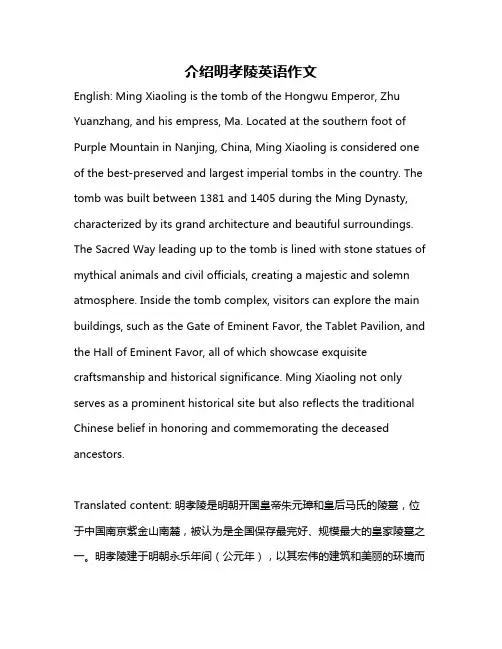
介绍明孝陵英语作文English: Ming Xiaoling is the tomb of the Hongwu Emperor, Zhu Yuanzhang, and his empress, Ma. Located at the southern foot of Purple Mountain in Nanjing, China, Ming Xiaoling is considered one of the best-preserved and largest imperial tombs in the country. The tomb was built between 1381 and 1405 during the Ming Dynasty, characterized by its grand architecture and beautiful surroundings. The Sacred Way leading up to the tomb is lined with stone statues of mythical animals and civil officials, creating a majestic and solemn atmosphere. Inside the tomb complex, visitors can explore the main buildings, such as the Gate of Eminent Favor, the Tablet Pavilion, and the Hall of Eminent Favor, all of which showcase exquisite craftsmanship and historical significance. Ming Xiaoling not only serves as a prominent historical site but also reflects the traditional Chinese belief in honoring and commemorating the deceased ancestors.Translated content: 明孝陵是明朝开国皇帝朱元璋和皇后马氏的陵墓,位于中国南京紫金山南麓,被认为是全国保存最完好、规模最大的皇家陵墓之一。
介绍明孝陵英语作文
介绍明孝陵英语作文Nestled within the verdant hills of Nanjing, Ming Xiaoling stands as a monumental testament to the grandeur and rich history of the Ming Dynasty. This mausoleum complex, dedicated to the founding emperor of the dynasty, Zhu Yuanzhang, and his queen, Ma, is not just a place of rest for the royal couple; it's a vivid snapshot of the cultural, artistic, and architectural brilliance of its time.The scale of Ming Xiaoling is immense, with over 200 buildings and structures spread across a vast area. The complex is divided into two main parts: the "Sacred Way" and the "Mausoleum Area." The Sacred Way, a long processional avenue leading to the main mausoleum, is lined with stone statues of various sizes and shapes, representing the dignity and power of the emperor. These statues, along with the elaborate carvings and sculptures adorning the road, exude a sense of awe-inspiring grandeur. The Mausoleum Area, on the other hand, is the heart of the complex. Here, the main mausoleum, the "Tomb of Zhu Yuanzhang," stands tall, surrounded by a wall of stoneterraces. Inside, the tomb is a serene and peaceful space, filled with the tranquility of the dead emperor and his queen. The intricate carvings and paintings on the wallsand ceilings add a touch of elegance to the otherwise austere interior.But Ming Xiaoling's charm doesn't just lie in its grandeur. It's also in the intricate details that make up the complex. From the delicate carvings on the stonetablets to the intricate patterns on the roof tiles, every element tells a story of the care and attention paid to the construction of this mausoleum. It's these details thattruly bring the history and culture of the Ming Dynasty to life.Moreover, Ming Xiaoling is not just a mausoleum complex; it's also a place of profound cultural significance. It's where the emperors of the Ming Dynasty were buried, and as such, it holds a special place in the hearts of the Chinese people. It's a symbol of respect and reverence for the past, a reminder of the rich history and culture that have shaped China into what it is today.In conclusion, Ming Xiaoling is much more than just a mausoleum; it's a historical and cultural landmark that tells the story of the Ming Dynasty. Its grandeur, detail, and significance make it a must-visit destination for anyone interested in Chinese history and culture. As one walks through its vast expanse, it's hard not to be moved by the sense of awe and respect that this place evokes. Ming Xiaoling is truly a testament to the splendor of the Ming Dynasty.**明孝陵:明朝辉煌历史的见证**坐落在南京郁郁葱葱的山峦之中,明孝陵不仅是明朝开国皇帝朱元璋及其皇后马氏的陵墓,更是明朝文化、艺术和建筑辉煌的生动写照。
南京明孝陵英语作文
南京明孝陵英语作文Ming Xiaoling Mausoleum, located at the southern foot of Purple Mountain in Nanjing, is the tomb of the founder of the Ming Dynasty, Zhu Yuanzhang, and his empress. Covering an area of 15 square kilometers, it is one of the largest imperial tombs in China.The mausoleum is famous for its grand scale, exquisite craftsmanship, and beautiful natural scenery. The Spirit Way, a 1800-meter-long road leading to the mausoleum, is lined with stone statues of mythical animals and officials. The main mausoleum buildings are made of precious materials and designed with intricate carvings, symbolizing the power and dignity of the Ming Dynasty.Visitors to the Ming Xiaoling Mausoleum can not only appreciate the historical and cultural significance of the site, but also enjoy the peaceful and picturesque surroundings. The mausoleum is a testament to the rich history and splendid culture of ancient China, and it is a must-see destination for tourists interested in Chinese history and architecture.南京明孝陵坐落在紫金山南麓,是明朝开国皇帝朱元璋和皇后的陵墓。
南京明孝陵英语导游词
南京明孝陵英语导游词(经典版)编制人:__________________审核人:__________________审批人:__________________编制单位:__________________编制时间:____年____月____日序言下载提示:该文档是本店铺精心编制而成的,希望大家下载后,能够帮助大家解决实际问题。
文档下载后可定制修改,请根据实际需要进行调整和使用,谢谢!并且,本店铺为大家提供各种类型的经典范文,如演讲致辞、总结报告、心得体会、合同协议、条据文书、策划方案、导游词、教学资料、作文大全、其他范文等等,想了解不同范文格式和写法,敬请关注!Download tips: This document is carefully compiled by this editor. I hope that after you download it, it can help you solve practical problems. The document can be customized and modified after downloading, please adjust and use it according to actual needs, thank you!Moreover, our store provides various types of classic sample essays for everyone, such as speeches, summary reports, insights, contract agreements, documentary evidence, planning plans, tour guides, teaching materials, complete essays, and other sample essays. If you want to learn about different formats and writing methods of sample essays, please stay tuned!南京明孝陵英语导游词钟山风景区以钟山(紫金山)和玄武湖为中心,包括84个可供观光游览的景点,分为明孝陵景区、中山陵景区、灵谷景区、头陀岭景区和其他景点五大部分。
明孝陵英文导游词Xiaoling Tomb of the Ming Dynasty
Xiaoling Tomb of the Ming Dynasty(Today we will visit Xiaoling Tomb of the Ming Dynasty, which was adopted as the Worlds Cultural Heritage in 2003)Xiaoling Tomb is the mausoleum of Zhu Yuanzhang, the founding emperor of the Ming Dynasty 600 years ago. The construction of the mausoleum started in 1381, and was completed in 1413 when “the Tablet of Great Merits of the Ming Tomb of the Great Ming Dynasty” was erected.Emperor Zhu Yuanzhang was born in a peasant family of Anhui Province in 1328. He lost his parents in his childhood and became a monk at Huangjue Temple. In 1352 he joined the Red Turban Army and became commanding general later. In 1368, he established his empire and made Nanjing the capital with a name of Ming for his dynasty. In 1398, he died and was buried here in the Xiaoling.The mausoleum consists of two major sections. The front section starts from”The Gateway of Dismounting Horses”at the Falial Guard to the Lingxing Gate at the end of Sacred Way. The whole approach is 1800 meters long. The Gateway of Dismounting Horse is engraved with 6 Chinese characters for warning worshipers, meaning”All the officials must dismount from the horse back here”.Go 700 meters northwest from the gateway, we can see a three-arched gate. It is known as the the Great Golden Gate, which is the front gate of the mausoleum, connecting with the red enclosure walls.Go through the Grand Golden Gate is a roofless pavilion, which is called Square City. In the middle of the pavilion there stands a huge stone tablet, which is 8.78m high with 2,746 characters carved on it. This is” the Tablet of Great Merits of the Ming Tomb of the Great Ming Dynasty”. The characters were written by Zhu Di, the third emperor of the Ming Dynasty.Go out of the Square City, we’ll come to the first section of the Sacred Way. The Sacred Way is divided into two sections. The front section is flanked by 12 pairs of stone animals in 6 kinds: each kind of the animals has 2 pairs, one standing and one kneeling. The animals are arranged in proper order: lions, Xiezhi, camels, elephants, unicorns and horses.Go straight a little bit forward, we can see two pillars, from where the sacred way makes a right turn. Here, we are at the second section of the Sacred Way, which is flanked by 4 pairs of stone Weng Zhongs: 2 pairs of generals and 2 pairs of officials.At the right of this path, we can see a small hill planted with thousands of plum trees. It is the Plum-Blossom Hill, which is Sun Quan’s tomb. The Hill is now a wonderful site for local people to appreciate plum blossom in spring when the trees are blooming.At the end of the Sacred Way, there is a gate named Lingxing Gate with three arches. It is alsocalled Dragon& Phoenix Gate. The rear section of the mausoleum starts from Lingxing Gate to the Citadel of Treasure and the Tomb Mound.About 270 meters away northeast of the Lingxing Gate there’s a stone bridge spanning over a small stream, which is called the Golden Water Bridge,. About 200 meters north of the bridge is the front gate of the tomb. At the right of the gate there is a tablet stone, which is inscribed with “The Special Notice” in 6 foreign languages to call for attention to protect the tomb. The tablet was established by Qing government.Inside the gate is a tablet pavilion, which is the entrance hall of the tomb. In this pavilion, there’s a tablet inscribed with “The Stele of Administrating the country as prosperous as the Tang and Song Dynasties”. The inscription was written by Kangxi, the emperor of the Qing Dynasty when he was paying his homage to the entombed emperor during his third inspection tour to the area in 1699.Go out of the pavilion, we’ll come to the site of the Sacrificial Hall. The original hall was very large and was used to enshrine Emperor Zhu Yuanzhang and his empress. The hall was destroyed in the war yet its 56 stone column bases are still there.Continue the visit towards north across a big stone bridge, we can see “The Citadel of Treasures and the Tomb Mound”. The Citadel of Treasures is the site of graveyard and the Tomb Mound is the tomb itself. The citadel is 39 meters long from west to east and 18 meters wide from north to south. Climb up 54 steps, coming into our view is the Tomb Mound, which is half circled by a stone wall. In the middle of the wall there are 7 Chinese characters, meaning” The hill is the very tomb of the Ming’s founding Emperor”. The tomb is covered by a large mound-400 meters in diameter. Emperor Zhu Yuanzhang and his empress are entombed in the underground. For the technical reasons of preservation, the tomb has not been excavated.。
- 1、下载文档前请自行甄别文档内容的完整性,平台不提供额外的编辑、内容补充、找答案等附加服务。
- 2、"仅部分预览"的文档,不可在线预览部分如存在完整性等问题,可反馈申请退款(可完整预览的文档不适用该条件!)。
- 3、如文档侵犯您的权益,请联系客服反馈,我们会尽快为您处理(人工客服工作时间:9:00-18:30)。
南京明孝陵导游词英文
篇二:南京明孝陵导游词英文
Xiaoling Tomb of the Ming Dynasty
Hello, everybody! Welcome to Xiaoling Tomb of the Ming Dynasty. It is the first world cultural heritage site in Nanjing.
Xiaoling Tomb is situated at the southern foot of Zijin Mountain in the east part of Nanjing, Jiangsu Province. It is the burial place of Zhu Yuanzhang, the first emperor of the Ming Dynasty, and his wife empress Ma. As one of the largest imperial tombs existent in China, Xiaoling became a major historic and cultural site under state protection in 1961. On July 3, 2003, together with the 13 Ming Tombs in Beijing, it was accepted into the World Heritage List as an associated site of “the imperial tombs of the Ming and Qing Dynasties”.
Ming Dynasty was the penult feudal regime in China’s history. Its founder, Zhu Yuanzhang, was often referred to as a “beggar emperor” for his miserable childhood.
Zhu was born into a poor peasant family in 1328 in Anhui Province neighboring Jiangsu. In 1344, a serious drought and plague swept the north of the Huaihe River. All his family
members died in succession during the disaster. To support himself, he entered a monastery near his village to be a monk at the age of 17, but before long he was sent out to beg alms for survival until 1348. At that time, peasant uprisings against the oppression of the Yuan Dynasty broke out in many places. One of the strongest forces was the Red Tie Army, so named because every soldier wore a red tie on the neck. At the age of 24, Zhu ran away from the monastery and joined the army. There he fought bravely and showed great talent as a strategist. He was quickly promoted to be one of the leading generals and married the commander’s adopted daughter. When the commander died, he succeeded him. Under his leadership, the army became stronger. After wiping out all the other rivals。
